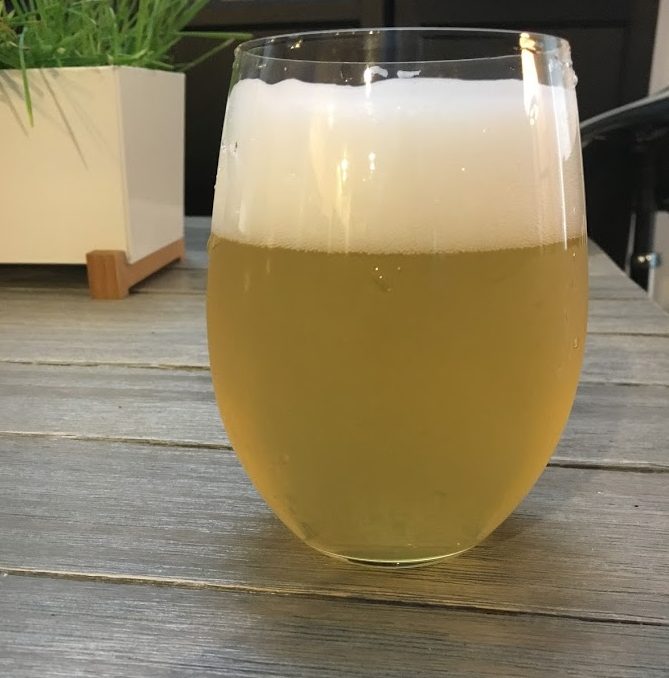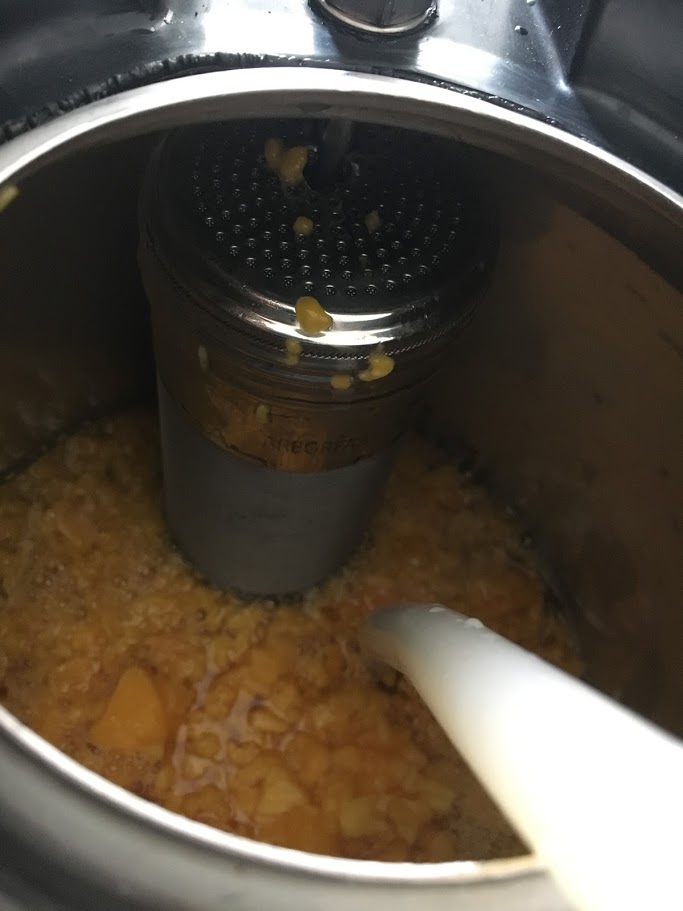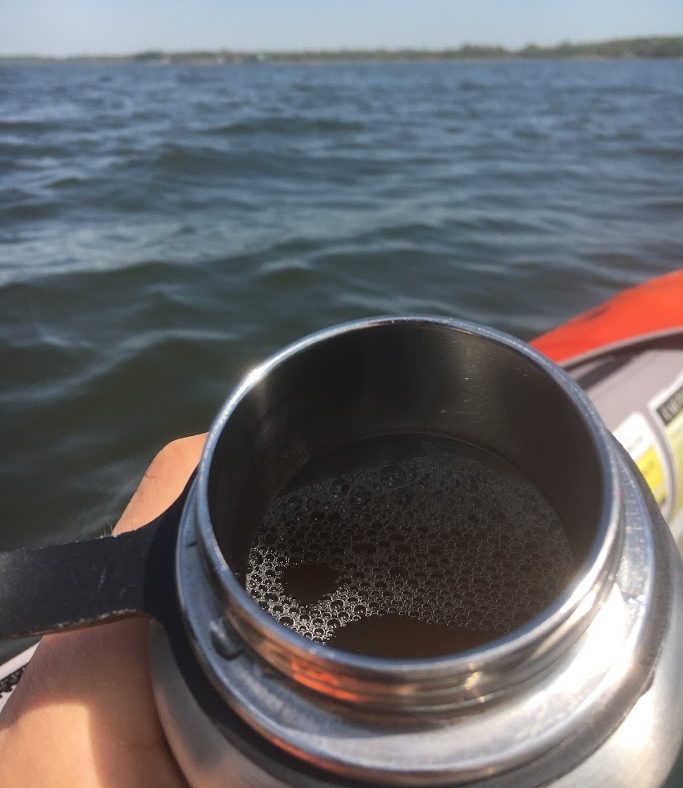
This certainly wasn’t the 5-gallon half of the 10-gallon batch I was most excited about on brew day, but after losing the full keg of the NEIPA half to the bottom of my kegerator, I shifted my excitement to the Saison half quickly!
Full keg of my 100% malted wheat WLP007 NEIPA gone in record time because it was so damn good! Or my ball lock wasn't completely seated… pic.twitter.com/FyIvCVTXoM
— Scott Janish (@ScottJanish) March 5, 2017
One of the issues I have when trying to mix together a “Saison” blend of yeast and bacteria is that it seems the Saison strains I include dominate the fermentation and don’t leave much for the Brett and bacteria to do, even with extended aging. I’m usually left wanting more fruity-funk character, less of that Saison spice dryness, more mouthfeel, and more acidity. In this blend attempt, I went with the French Saison strain (Wyeast 3711), a blend of six Brettanomyces strains in the Yeast Bay’s Amalgamation blend along with dregs of Tired Hands Freedom From the Known blend, which I’ve had success in the past with fairly short souring durations. My thought process was that my primary strain would give me a little “Saison” character with a nice soft mouthfeel that 3711 can provide, a blend of Brett strains that are supposed to lean towards the fruity side of funk and a quick souring blend for a little acidity.
Being the grist was 100% malted wheat, I avoided the concerns of a stuck sparge by using a newly purchased mash filter bag (inspired by the Brulosophy folks). I’ve struggled on and off with stuck sparges when doing strange grists like with huge amounts of oats, or flaked grains (kamut, quinoa, wheat), and even using wheat and rye flour at times. I hope to permanently solve these stuck sparges with this bag. So far I’ve adjusted my mill to narrow the gap for finer crush and done a few high oat beers and this 100% malted wheat beer with zero issues. So far so good!
Recipe
Water: 100% RO treated with 0.15 grams/gallon gypsum and 0.75 grams/gallon calcium chloride
OG: 1.040
FG: 1.002
ABV: 5.0%
IBU: 3.7
Grist:
98.5% Malted Wheat
1.5% Acidulated Malt
Mashed at 158°F
Boil: 60 Minutes
Hops:5 grams Citra @30 minutes
Yeast: Freedom from the Known (Tired Hands Dregs) + French Saison + Yeast Bay Amalgamation Brett Blend and kegged with Lalvin 71B-1122
Fermentation: 70°F Ambient
Fruit: Four pounds of frozen organic mangos pulsed in blender added to keg at 5-weeks (used as priming sugar as well)
After five weeks in primary, I gave the beer a sample and wasn’t thrilled with where I was at. Already down to 1.002 there wasn’t much noticeable acidity and the overall character was a little spicy, dry, and a fair amount funk that leaned a bit metallic. So again, I didn’t quite get the results from the blend of yeast and bacteria I was hoping for. I wasn’t originally planning on adding fruit to this beer, but I thought I needed to do something to it or it would be something I’d have on tap forever! I decided to fruit it with mango, hoping it would add a nice soft mellow flavor with some “fruit” aroma to make up for the lack of fruit-funk I wanted. Rather than rack the beer into secondary to age on the fruit, I decided to experiment with carbonating the beer with the fruit addition by adding it directly to a keg and sealing it up. I used a 4-pound bag of organic frozen mango chunks, which I first pulsed in a Vitamix to break it up a bit more to encourage more extraction. With a filter around the dip tube, I wasn’t worried about clogging anything and with a spunding valve set to 25 PSI (which at room temperature should get me to around 2.4 volumes of CO2) I wasn’t afraid of over carbonating the beer. I also wondered if the sealed fruit addition might help preserve some of the subtle mango characteristics by not being bubbled out of an airlock.
I also added a few grams of hydrated Lalvin 71B-1122 (wine yeast) at the time of adding the mango for a few (hopeful) reasons. The major acids in mangos are found to be citric and malic acids1, of which, wine yeasts like 71B have been tested to partially metabolizing the malic acid.2 As understand this process, this malolactic fermentation or MLF in winemaking takes a tart-tasting malic acid into a softer lactic acid. In addition, MLF also can have the added benefit (if that’s what you after) of creating a “rounder, fuller mouthfeel,” which I’m almost always after.3 A byproduct of this process, however, can be diacetyl, which I was a little afraid of with the keg capped. However, once the keg reached 25 PSI, it should start venting. I should say that this isn’t a 100% fruit fermentation, so the malic acids are much lower, but I’m still curious if a secondary strain used for such a short duration can have an impact despite all the other yeast and bacteria that are still in suspension.
In addition to 71B-1122 malolactic ability, it’s also been tested to be a Beta-glucosidase producer, which is an enzyme that can enhance fruit flavors by releasing non-volatile glycosides that reside on the fruit. In fact, one study of 17 different strains found that 71B-1122 had the highest level of beta-glucosidase activity. The result of the beta-glucosidase activity in the wine tested showed a significant increase in nerol and geraniol, which likely played a part in scoring higher in aroma and flavor by a sensory panel than the control.4 Both nerol (rose, citrus) and geraniol (rose) are monoterpene alcohols that are also found in hops. Citra, for example, contains high amounts of geraniol.5

Fig. 1 Quantification of -glucosidase activity of the 17 yeast strains. Wanapu, C., Sripunya, P., & Boonkerd, N. (2012). Selection of Yeast Strains Containing B-Glucosidase for Improving Wine Aroma. Journal of Agriculture Science and Technology.Wanapu, C., Sripunya, P., & Boonkerd, N. (2012). Selection of Yeast Strains Containing B-Glucosidase for Improving Wine Aroma. Journal of Agriculture Science and Technology.
So, the addition of 71B-1122 during keg conditioning time could potentially metabolize the malic acid from the mango into a softer lactic acid while also boosting the mouthfeel. It may also result in bioflavoring by releasing glycosidically bound flavors in the mango with its high beta-glucosidase activity. At just $0.99, experimenting with 71B-1122 certainly won’t set you back much, seems like a great dry yeast strain to have on hand!
After a little over a week, the beer had already reached 25 PSI from the natural sugars added from the mango chunks. I left the beer for another 2 weeks to make sure all the activity had stopped by lowering the PSI to 23 PSI and waited a few days to see if it increased or not. With no activity on the spunding valve, I figured everything was done and put the carbonated keg into the keezer. I found out that if you fill the keg up to the top and let it ferment like this and decide to release some pressure quickly from the spunding valve, you’ll get mango beer flying out the end! Probably best to release the pressure slowly or just set it to your desired pressure and let it be.
Results
What an improvement from the base beer! In the aroma, I get just a hint of mangos, with a light Brett funk character and a little graininess. There is still a little of that peppery quality, which for some reason at times still comes across to me as metallic.The head retention is perfect…for about 20 seconds and then falls to very thin layer.
The mouthfeel is pretty nice, fairly rich and soft despite the final gravity of 1.002. This probably in large part because of the French Saison strain as well as potentially the 71B-1122 combined with the fruit. I wish now that I would have set some aside before the fruit addition for a side-by-side to compare the mouthfeel. It has some of that NEIPA-like creaminess that some might not like in a Saison, but I’m a sucker for in pretty much every style. The acidity is light, could use a bit more. There is a little mango in the flavor initially, but the dryness seems to cut this down quickly as well as a touch of alcohol. I think I’d add another pound or two of frozen mango chunks to boost the flavor a bit.
I continue to be interested in the literature on winemaking and looking for ways to incorporating some it into brewing beer, especially when fruit is involved. So although I never intended to use fruit in this beer, I’m glad it wasn’t that great initially, it got me to poke around a bit in some research and inspired a few more brewing ideas!
Footnotes
- Medlicott, A. P., & Thompson, A. K. (1985). Analysis of sugars and organic acids in ripening mango fruits (Mangifera indica L. var Keitt) by high performance liquid chromatography. Journal of the Science of Food and Agriculture,36(7), 561-566. doi:10.1002/jsfa.2740360707
- http://www.lallemandbrewing.com/product-details/lalvin-71b/
- J. Robinson (ed) “The Oxford Companion to Wine” Third Edition pgs 422 & 508 Oxford University Press 2006 ISBN 0-19-860990-6
- Wanapu, C., Sripunya, P., & Boonkerd, N. (2012). Selection of Yeast Strains Containing B-Glucosidase for Improving Wine Aroma. Journal of Agriculture Science and Technology.
- Takoi, K., Itoga, Y., Koie, K., Kosugi, T., Shimase, M., Katayama, K. Nakayama, Y., and Watari, J. Contribution of geraniol metabolism to citrus flavour of beer: synergy of geraniol and β-citronellol under co- existence with excess linalool. J. Inst. Brew. 116:251-260, 2010.





-610x915.jpg)
Is it a no boil raw ale?
Glad you caught that! It was a 60-minute boil, I’ll add that into the recipe.
Have you looked into whether 71B-1122 can unlock glycosides in hops?
https://lifefermented.wordpress.com/2014/12/17/unlocking-hop-and-fruit-flavors-from-glycosides/#comment-1157/
I’ve been interested in testing out the hypothesis the author mentions but I’ve found it very difficult to source the enzymes required. Wine yeast, on the other hand, might be much easier to come by!
The hypothesis is backed up by a few other mentions, including this fascinating paper by the brewers at Orval:
http://ot-ds.sipr.ucl.ac.be/cps/ucl/doc/inbr/documents/presentation-jean-marie-rock.pdf
http://www.milkthefunk.com/wiki/Hops#cite_note-22
Just to note – this would be in beers without fruit added…
Thanks for sharing the links! I’ve actually experimented with this strain in hops and was fairly happy with the results, lots of big Grapefruit character when used in combination with Nelson Sauvin. In addition, I’ve also used it as a secondary strain to carbonate a NEIPA without even adding sugar, and the result was completely different than the base beer. The wine strain definitely seemed to cut down on the dankness of the original Mosaic lupulin powder beer and added a pronounced grapefruit character.
https://twitter.com/ScottJanish/status/853375498411495424
I need to explore this more!
Very interesting! When you did the NS beer, did you pitch a beer yeast as well, or just let the wine yeast get on with it?
Yeast blending – now there’s another area that feels like it needs more investigation.
I am about to bottle my saison that I made with a large amount of local wheat (farro) and the same yeasts, minus the dregs. I used a fair amount of ekg in the late boil, but I am also a bit disappointed with the current flavor. My Brett starter was much more tasty. I’m thinking of dry hopping with mosaic to make up for the lack of fruit
I meant to add that it is quite the coincidence! Perhaps these two yeasts just don’t work well together
That is a coincidence! How long have you been sitting on your beer? Did the Saison yeast take over like in my case? Mosaic is always one of my favorite dry hops in Saisons, hard to go wrong there!
It’s only been two and a half weeks since brew day. I *think* the saison taking over is what I’m tasting, but then again, it’s not terribly aggressive. I had made a starter for the Amalgamation as I really wanted it to keep up with the 3711, and it tasted excellent after only two weeks. Plenty of brett zip, fruit and funk, whereas the saison is more muted, peppery and “damp” tasting. Of course, making a starter probably threw off the balance of strains in the Amalgamation, but I can’t imagine that would end up as a lack of character in the saison.
Fantastic sounding beer. Seems like the funk would go nice with mango!